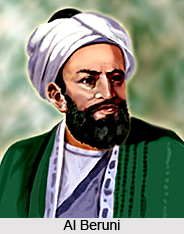 The Sultans and the rulers of provincial dynasties gave huge importance to literature. They provided shelter to different scholars who produced historical, religious literature in other fields of knowledge. Literature was produced not only in Persian and Sanskrit but also in other religious languages. Books were written in the form of prose, drama and poetry. The saints of Bhakti movements also participated in the literatures of the regional languages.
The Sultans and the rulers of provincial dynasties gave huge importance to literature. They provided shelter to different scholars who produced historical, religious literature in other fields of knowledge. Literature was produced not only in Persian and Sanskrit but also in other religious languages. Books were written in the form of prose, drama and poetry. The saints of Bhakti movements also participated in the literatures of the regional languages.
The Sultans of Delhi were interested in the progress of Persian literature. Al-beruni, who visited India in the company of Mahmud of Ghazni, was a great scholar. Most Sultans of Delhi led protection to scholars of Persian at their court which help-i he growth of Persian literature. Khwaja Abu Nasr, poetically called Naisiri, Abu Bakar bin Muhammad Ruhani, Taj-ud-din and Nur-ud-din Muhammad Awfi were famous scholars in the court of Sultan Iltutmish. Many Muslim scholars from Persia and Central Asia fled away from there because of the Mongols and found shelter at the courts of Sultan Balban and Ala-ud-din Khilji. Prince Muhammad the eldest son of Sultan Balban was a patron of scholars and provided protection to two greatest scholars of his times, that is, Amir Khusrau and Amir Hasan.
Amir Khusrau has been regarded as the greatest Persian poet of his age and is said to have written more than four lakhs of couplets. He wrote a number of prose books also, most famous of them being the Khazain-ul-Fatuh, Tughlaq -nama, and the Tarikh-i- Alai. A large number of scholars flourished at the courts of provincial rulers as well. Sayyid Muin- ul- haq was famous in Sindh, Ibrahim Farukhi flourished in Bihar and Fazlullah Zain-ul-Abidin was a scholar of Gujarat. Translation of certain Sanskrit books was also done in Persian language during this period.
The Hindu rulers, particularly those of Warangal and the Vijayanagara Empire provided encouragement to Sanskrit literature. Different types of works such as poetry, drama etc. were produced in Sanskrit and good works on philosophy and religious commentaries were written by various scholars. Hammir Deva, Kumbha Karna, Prataprudra Deva, Basantraja, Vemabhubhala, Katya Vem, Virupakaya, Narsingh, Krisnadevaraya, Bhupal, and many other alike rulers patronised Sanskrit scholars and encouraged their writings and a few of them were themselves scholars.
The one novelty of this period in literary field was the beginning of literature in different regional languages of India. The Khariboli and Brajbhasa mostly spoken in western Uttar Pradesh provided the base for the growth of Hindi literature. Amir Khusrau was regarded as a writer of both Hindi and Urdu. Vidyapati Thakur who wrote works in Sanskrit, Hindi and Maithili encouraged the foundation of Maithili literature towards the end of the fourteenth century. The saints of Bhakti movement who gave their messages in the languages of the people also helped in the expansion of different regional languages and thereby their literatures. This period, thus, witnessed the beginning of the growth of nearly all regional languages of India like Bengali, Punjabi, Sindhi, Gujarati, Marathi, Kannada, Telugu, Tamil, and Malayalam etc.
This period witnessed the growth of literature in different literature and different languages and was remarkable at least from two points of view. One was that historical texts were prepared during this period because of the Muslim court writers which was mostly neglected by the Hindus; and, secondly, it marked the beginning of literatures of different Indian regional languages.



















